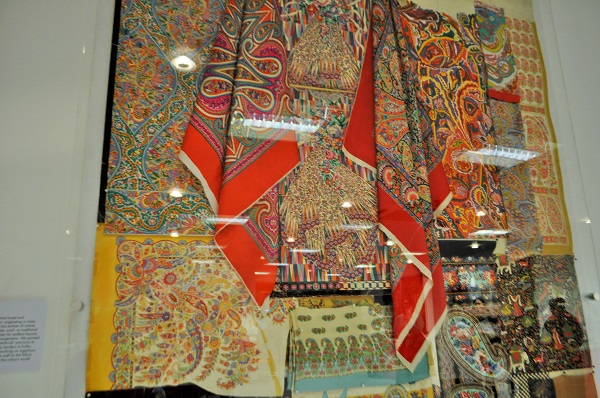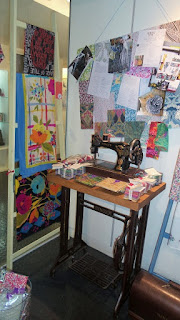The notion of wearable art is not new and quite often we find in museum and gallery shops the choice of gifts and souvenirs are limited to Tee shirts, shopping bags and scarfs albeit the prints taken from masterpieces are incorporated in their collections.
Now a company based in East Sussex in the UK has joined forces with The National Gallery in London in a project that sees images from some of the world’s greatest paintings feature on its range of leggings.
 |
Model Simone Wells wearing A Still Life of Flowers
in a Wan-Li Vase’ by Ambrosius Bosschaert the Elder. |
Following an approach from The National Gallery, Wild Bangarang has introduced fashion lines for leggings that feature the masterpieces ‘Sunflowers’ and ‘A Wheatfield, with Cypresses’ by Vincent van Gogh and ‘A Still Life of Flowers in a Wan-Li Vase’ by Ambrosius Bosschaert the Elder.
The leggings are being sold on-line and soon at The National Gallery, which houses a collection of over 2,300 paintings dating from the mid-13th century to 1900.
 |
| Adam Jay at Wild Bangarang HQ |
Wild Bangarang was set up by entrepreneurs Adam Jay and David Pearson in 2014 and specialises in printed clothing. To date, the company’s success has been built on designs based on pop culture such as World of Warcraft and Power Rangers.
Adam, a photographer, started a ‘superhero creations’ Facebook page several years ago and it engaged with a huge online community, achieving 950,000 likes. Adam and David both felt that the quality and variety of apparel servicing the ‘geek’ market was lacking and identified a business opportunity there.
“Looking at the athleisure market and the projected growth, we couldn't find a home-grown business focusing on this sector so we decided that could be us! Wild Bangarang was started to reach that market window. Initially with a handful of designers, we set off on our venture.”
Now in year two, the business has turned over £350,000 which gave the company the encouragement to see the potential for growing the market sector.
Adam said: “We pride ourselves on dedication and a personal touch to each of our garments. This is attractive to brands like The National Gallery which has strong guidelines and wants to protect its image.
“We always work carefully on samples to make sure the colours and design are authentic and true to the brand, which makes our product the best on the market for printed leggings.
“The National Gallery designs were a challenge for us as we couldn’t edit a famous piece of art just to fit the leg shape,” said Adam.
The pair have plans to expand their range further to meet demand, travelling all over the world to fashion, comic and licensing events to showcase Wild Bangarang’s range. So watch this space!
 |
| A treasure trove of inspirational prints and patterns by designers of Liberty from 1961 - 77 are on show at The Art of Pattern 9 Otober 2015 - 29 February 2016 at the Fashion and Textile Museum. |
It’s official –floral-printed shirts and blouses are the key fashion item this autumn, according to WGSN, as the 1970s trend continues to grip our imagination and is predicted to stay hot well into Spring at least.
WGSN’s Instock data reveals that fashion-conscious consumers are drawn to a number of 70s-retro styles now available on the high street, from “those super feminine, frilled and pussy-bowed numbers” to Western-shirt styles, and that amorous rose prints and bold retro floral patterns are among the best-sellers.
And for fashionistas and all working in the industry alike looking for more inspiration for this trend, what better way than to have access to valuable archives of original inspiration floral prints and retro patterns in their research.
Head over to the Fashion and Textile Museum in London's Bermondsey Road, and you will find an invaluiable event called The Art of Pattern now on until 28 February 2016 as part of the major Liberty in Fashion exhibition in the FTM.
The Art of Pattern showcases a wide range of work by two designer-sisters: Susan Collier & Sarah Campbell, who were producing print patterns for Liberty between 1961 – 77, from scarfs to fashion and furnishing fabrics.
There are more than 100 originally hand-painting designs, sketches, printed swatches, fabric lengths and objects to highlight the designers' painterly approach to fashion and furnishing textiles.
There are more than 100 originally hand-painting designs, sketches, printed swatches, fabric lengths and objects to highlight the designers' painterly approach to fashion and furnishing textiles.
 |
| Along with swatches of floral fabrics on show were Limited edition hand-made dolls (which are also on sale in the FTM shop) using vintage Liberty fabrics. |
The exhibition though small showcases some of the most recognisable textile designs of the late 20th century.
Among the designs is a range of florals and patterns that according to the designers were created based on the traditional design motif of Liberty - a little floral on Tana Lawn, Watch out for tiny butterflies and Buddliea, bold Anemones and Ramunculas. Some of the designs were coloured exclusively for fashion houses such as Cacharel and couturiers like Yves St Laurent and a great many of the designs went to the Liberty store and then into the hands of many home-sewers.
Paisleys, one of the most popular and most interpreted motifs in design was widely used. Originating from India and the Orient where the Liberty founder Sir Arthur Lazenby Liberty was sourcing widely when he first established his store. According to designers Collier and Campbell, "We painted widely, from tiny 'one-whisker-brush' precision to the grand sweep, deep lacey borders to frothy floral flounces.
Sarah Campbell notes: "That the quality of the painted mark is very important and gives beauty and energy to the fabric has always been a guiding principle."
 Also much admired was the hugely successful 'Bauhaus' print which was adopted from a tapestry in the 1920s and was originally produced as a scarf (c. 1969) and then modified in 1972 for use on Linen and Cotton Union furnishing fabric. It was also printed on Varuna wool for
Cacharel (1970) (on display in the main Liberty in Fashion show) and produced Chinon for Liberty's 1975 centenary collection.
Also much admired was the hugely successful 'Bauhaus' print which was adopted from a tapestry in the 1920s and was originally produced as a scarf (c. 1969) and then modified in 1972 for use on Linen and Cotton Union furnishing fabric. It was also printed on Varuna wool for
Cacharel (1970) (on display in the main Liberty in Fashion show) and produced Chinon for Liberty's 1975 centenary collection.While the designers - Susan Collier and Sarah Campbell - drew on iconic Liberty patterns, they sought to reinterpret them and introduce their own creative energy and preoccupations. In spite of the constraints of mass production, their looser painterly aesthetic became evident in designs of abundant soft florals, bold stripes and fre abstracts. Sarah Campbell notes: "That the quality of the painted mark is very important and gives beauty and energy to the fabric has always been a guiding principle."
Coinciding with Liberty in Fashion and The Art of Pattern is a wide range of Liberty print-themed merchandise and products on sale at the Fashion and Textile Museum shop.
From a range of Liberty focused books to sewing fabric lengths, Liberty print stationery and limited edition finds.
Great ideas to fire up your creative home-sewing juices and just in time for Christmas.
All photos of the exhibition by Lucia Carpio for My Fashion Connect.












No comments:
Post a Comment